Castaways spell ‘help’ with palm branches: A Pacific rescue tale
Loading...
In a real-life castaway tale, three men were rescued Thursday after a US Navy aircraft spotted their SOS - palm fronds laid out on a beach, spelling the word ‘HELP’.
The trio found themselves stranded when the skiff they were riding between two Micronesian islands ran into trouble, forcing them to strike out into the ocean and swim two miles towards the nearest piece of land they could see.
For three days, they tasted the life of Tom Hanks’s character in the 2000 movie "Cast Away," whose antics reportedly gave them the inspiration for their leafy inscription in the sand.
"Our combined efforts coupled with the willingness of many different resources to come together and help, led to the successful rescue of these three men in a very remote part of the Pacific," said Lt. William White, US Coast Guard’s Sector Guam public affairs officer, in a statement.
The alert was raised by the men’s families Monday, when they failed to report for a scheduled flight on the island of Chuuk.
Four ships set sail to comb the area once authorities became aware of the predicament, but it was a Navy P-8 aircrew from Misawa Air Base in Japan who came across the trio, drawn by their palm fronds and frantic waving, just two hours after joining the search.
The rescue effort marks the US Coast Guard’s seventh in the area since March 28, but in such a vast and remote region, resources have to be pooled if missions are to stand a chance of success, as Jennifer Conklin, search and rescue mission coordinator at the Coast Guard Command Center Honolulu, explained.
"The Coast Guard 14th District covers an area of responsibility more than 12.2 million square miles of land and sea, an area almost twice the size of Russia," said Ms. Conklin. "Oftentimes, we are thousands of miles away from those who need help and because of that our partnerships with the Navy, other search and rescue organizations, partner Pacific nations and AMVER are essential."
AMVER, sponsored by the US Coast Guard, is a voluntary computer-based ship reporting system, used worldwide to assist in search and rescue efforts. It allows coordinators to identify ships in the vicinity when a distress call is received, enabling them to assign the nearest and most capable ships to divert and approach the stricken vessel.
Here's how the Coast Guard describes the system's inception:
Originally known as the Atlantic Merchant Vessel Emergency Reporting (AMVER) System, it became operational on July 18, 1958. Amver began as an experiment, confined to waters of the North Atlantic Ocean, notorious for icebergs, fog and winter storms. Vice Admiral Alfred C. Richmond, Coast Guard Commandant at the time, called on all commercial vessels of U.S. and foreign registry, over 1,000 gross tons and making a voyage of more than 24 hours, to voluntarily become Amver participants. The basic premise of Amver, as a vehicle for mariner to help mariner without regard to nationality, continues to this day.
The location of this latest rescue was an uninhabited island in the Federated States of Micronesia, an archipelago of more than 600 islands. The US Coast Guard lends assistance in search and rescue efforts due to a paucity of local capacity.
“There are not a lot of resources in that region. It's very small and very remote,” Chief Petty Officer Sara Mooer, a spokesperson for the Coast Guard, told CNN.








